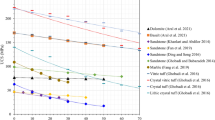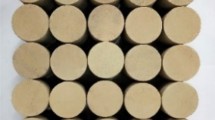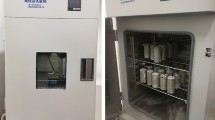Abstract
In this study, a new approach based on DEM was developed to simulate the damage of water-rich rock after freeze–thaw cycles. In this way, water-rich rock samples at low temperatures were simplified as rock particles, ice particles, rock–rock contacts, rock–ice contacts, and ice–ice contacts. The volume of the ice particles changed as the temperature changed. The change characteristics were determined by the relationship between the temperature and the unfrozen water content. The developed approach was proven to be effective by comparing the simulation results with the laboratory test results. The physico-mechanical behaviors of water-rich rock samples after freeze–thaw cycles were studied. The results showed that the volume and porosity significantly increased after the freeze–thaw cycles, especially after 15 freeze–thaw cycles, and the increase in the radius was significantly larger than the increase in height. The uniaxial compressive strength, elastic modulus, and peak strain had an exponential reduction as the number of cycles increased. In uniaxial compression tests, the tensile failure rate of the sample after freeze–thaw cycles increased compared with that of the sample without freeze–thaw cycle treatment. With the increase in the number of freeze–thaw cycles, the distribution of cracks in the rock sample was more homogeneous. However, overall, the cracks that formed due to the freeze–thaw cycles were more distributed near the surface of the sample.
















Similar content being viewed by others
References
Aleksyutina DM, Motenko RG (2016) The effect of soil salinity and the organic matter content on the thermal properties and unfrozen water content of frozen soils at the west coast of Baydarata Bay. Mosc Univ Geol Bull 71(3):275–279
Anderson DM, Tice AR (1971) Low–temperature phases of interfacial water in clay–water systems. Soil Sci Soc Am J 35(1):47–54
Anderson RS, Anderson SP, Tucker GE (2013) Rock damage and regolith transport by frost: an example of climate modulation of the geomorphology of the critical zone. Earth Surf Proc Land 38(3):299–316
Ballantyne CK, Sandeman GF, Stone JO, Wilson P (2014) Rock–slope failure following Late Pleistocene deglaciation on tectonically stable mountainous terrain. Quatern Sci Rev 86:144–157
Chen YL, Ni J, Jiang LH, Liu ML, Wang P, Azzam R (2014) Experimental study on mechanical properties of granite after freeze–thaw cycling. Environ Earth Sci 71(8):3349–3354
Chen Y, Wu P, Yu Q, Xu G (2017) Effects of freezing and thawing cycle on mechanical properties and stability of soft rock slope. Adv Mater Sci Eng 2017:1–10
Christ M, Kim YC (2009) Experimental study on the physical–mechanical properties of frozen silt. KSCE J Civ Eng 13(5):317–324
Drotz SH, Tilston EL, Sparrman T, Schleucher J, Nilsson M, Öquist MG (2009) Contributions of matric and osmotic potentials to the unfrozen water content of frozen soils. Geoderma 148(3–4):392–398
Guo JT, Zhang ZM, Tang YL, Ji J (2020) A simplified viscoelastic solution of the frost heaving force of cavity water behind tunnel linings. Adv Civ Eng 2020:1–8
Handa YP, Zakrzewski M, Fairbridge C (1992) Effect of restricted geometries on the structure and thermodynamic properties of ice. J Phys Chem 96(21):8594–8599
Huang D, Zhu T (2018) Experimental and numerical study on the strength and hybrid fracture of sandstone under tension–shear stress. Eng Fract Mech 200:387–400
Huang S, Liu Q, Liu Y, Ye Z, Cheng A (2018) Freezing strain model for estimating the unfrozen water content of saturated rock under low temperature. Int J Geomech 18(2):04017137
Ishizaki T, Maruyama M, Furukawa Y, Dash JG (1996) Premelting of ice in porous silica glass. J Cryst Growth 163(4):455–460
Ji WD, Kang YS, An XY, Zhao Y (2014) Simulation on freeze–thaw action in multi–cracks in rock mass. Adv Mater Res 1049–1050:426–429
Jia H, Liu Q, Xiang W, Zhang W, Lang L (2013) Damage evolution model of saturated sandstone under freeze–thaw cycles. Chin J Rock Mechan Eng 32(S2):3049–3055
Jin DW, Sun JF, Fu SL (2005) Discussion on landslides hazard mechanism of two kinds of low angle slope in permafrost region of Qinghai-Tibet plateau. Rock Soil Mech 26(5):774–778 (in Chinese)
Kang Y, Hou C, Liu B, Liu Q, Tian Y (2020) Frost deformation and a quasi–elastic–plastic–creep constitutive model for isotropic freezing rock. Int J Geomech 20(8):04020119
Khanlari G, Sahamieh RZ, Abdilor Y (2015) The effect of freeze–thaw cycles on physical and mechanical properties of upper red formation sandstones, central part of Iran. Arab J Geosci 8(8):5991–6001
Kolaian JH, Low PF (1963) Calorimetric determination of unfrozen water in montmorillonite pastes. Soil Sci 95(6):376–384
Kolay E (2016) Modeling the effect of freezing and thawing for sedimentary rocks. Environ Earth Sci 75(3):210
Kozlowski T (2003) A comprehensive method of determining the soil unfrozen water curves: 1. application of the term of convolution. Cold Regions Sci Technol 36(1–3):71–79
Kozlowski T (2009) Some factors affecting supercooling and the equilibrium freezing point in soil–water systems. Cold Reg Sci Technol 59(1):25–33
Lai J, Qiu J, Fan H, Chen J, Xie Y (2016) Freeze–proof method and test verification of a cold region tunnel employing electric heat tracing. Tunn Undergr Space Technol 60:56–65
Li X, Qu D, Luo Y, Ma R, Xu K, Wang G (2019) Damage evolution model of sandstone under coupled chemical solution and freeze–thaw process. Cold Reg Sci Technol 162:88–95
Li H, Ma E, Lai J, Wang L, Liu T (2020) Tunnelling–induced settlement and treatment techniques for a loess metro in Xi’an. Adv Civ Eng 2020(1):1–20
Li A, Dai F, Liu Y, Du HB, Jiang RC (2021) Dynamic stability evaluation of underground cavern sidewalls against flexural toppling considering excavation–induced damage. Tunn Undergr Space Technol 112:103903
Liu Q, Huang S, Kang Y, Pan Y (2016) Study of unfrozen water content and frost heave model for saturated rock under low temperature. Chin J Rock Mechan Eng 35(10):2000–2012 (in Chinese)
Liu H, Yuan X, Xie T (2019) A damage model for frost heaving pressure in circular rock tunnel under freezing–thawing cycles. Tunn Undergr Space Technol 83:401–408
Liu T, Xie Y, Feng Z (2020a) Better understanding the failure modes of tunnels excavated in the boulder–cobble mixed strata by distinct element method. Eng Fail Anal 116:104712
Liu C, Deng H, Chen X, Xiao D, Li B (2020b) Impact of rock samples size on the microstructural changes induced by freeze–thaw cycles. Rock Mech Rock Eng 53:5293–5300
Lomboy G, Sundararajan S, Wang K, Subramaniam S (2011) A test method for determining adhesion forces and Hamaker constants of cementitious materials using atomic force microscopy. Cem Concr Res 41(11):1157–1166
Luo X, Jiang N, Fan X, Mei N, Luo H (2015) Effects of freeze–thaw on the determination and application of parameters of slope rock mass in cold regions. Cold Reg Sci Technol 110:32–37
Lyu Z, Xia C, Liu W (2020) Analytical solution of frost heaving force and stress distribution in cold region tunnels under non–axisymmetric stress and transversely isotropic frost heave of surrounding rock. Cold Reg Sci Technol 178:103117
Mu JQ, Pei XJ, Huang RQ, Rengers N, Zou XQ (2017) Degradation characteristics of shear strength of joints in three rock types due to cyclic freezing and thawing. Cold Reg Sci Technol 138:91–97
Nakano Y, Martin RJ, Smith M (1972) Ultrasonic velocities of the dilatational and shear waves in frozen soils. Water Resour Res 8(4):1024–1030
Park K, Kim K, Lee K, Kim D (2020) Analysis of effects of rock physical properties changes from freeze–thaw weathering in Ny–lesund Region: Part 1–Experimental Study. Appl Sci 10(5):1707
Patterson DE, Smith MW (1980) The use of time domain reflectometry for the measurement of unfrozen water content in frozen soils. Cold Reg Sci Technol 3(2–3):205–210
Potyondy DO, Cundall PA (2004) A bonded–particle model for rock. Int J Rock Mech Min Sci 41:1329–1364
Prick A (1995) Dilatometrical behaviour of porous calcareous rock samples subjected to freeze–thaw cycles. CATENA 25(1):7–20
Qiao GW (2019) Study on the mechanism of the freeze–thaw slope and rock mass quality evaluation system in Tianshan Mountain area. Chengdu University of Technology (in Chinese)
Shen Y, Wang Y, Wei X, Jia H, Yan R (2020) Investigation on meso–debonding process of the sandstone–concrete interface induced by freeze–thaw cycles using NMR technology. Constr Build Mater 252:118962
Spaans EJA, Baker JM (1995) Examining the use of time domain reflectometry for measuring liquid water content in frozen soil. Water Resour Res 31(12):2917–2925
Sparrman T, Oquist M, Klemedtsson L, Jürgen S, Nilsson M (2004) Quantifying unfrozen water in frozen soil by high–field 2H NMR. Environ Sci Technol 38(20):5420–5425
Tice AR, Burrous CM, Anderson DM (1978) Phase composition measurements on soils at very high water contents by the pulsed nuclear magnetic resonance technique. Transp Res Record J Transp Res Board 375(3):11–14
Timur A (1968) Velocity of compressional waves in porous media at permafrost temperatures. Geophysics 33(4):584–595
Tran KM, Bui HH, Sánchez M, Kodikara J (2020) A DEM approach to study desiccation processes in slurry soils. Comput Geotech 120:103448
Wang DY, Zhu YL, Ma W, Niu YH (2006) Application of ultrasonic technology for physical–mechanical properties of frozen soils. Cold Reg Sci Technol 44(1):12–19
Wang Y, Feng WK, Wang HJ, Li CH, Hou ZQ (2020a) Rock bridge fracturing characteristics in granite induced by freeze–thaw and uniaxial deformation revealed by AE monitoring and post–test CT scanning. Cold Reg Sci Technol 177:103115
Wang Y, Han JQ, Li CH (2020b) Acoustic emission and CT investigation on fracture evolution of granite containing two flaws subjected to freeze–thaw and cyclic uniaxial increasing–amplitude loading conditions. Constr Build Mater 260:119769
Weng L, Wu Z, Taheri A, Liu Q, Lu H (2020) Deterioration of dynamic mechanical properties of granite due to freeze–thaw weathering: considering the effects of moisture conditions. Cold Reg Sci Technol 176:103092
Winkler EM (1968) Frost damage to stone and concrete: geological considerations. Eng Geol 2(5):315–323
Wu GP, Chen WW, Cui K, Wang P (2019) Degradation behavior and mechanism of slate under alternating conditions of freeze–thaw and wet–dry. J Central S Univ Sci Technol 50(6):1392–1402
Xu S, Li N, Xu G, Wang X, Tian Y, Yuan K, Wang L (2016) Thermal transfer and heat balance of saturated rock under freezing–thawing environment. Chin J Rock Mechan Eng 35(11):2225–2236 ((in Chinese))
Yang P, Ke JM, Wang JG, Chow YK, Zhu FB (2006) Numerical simulation of frost heave with coupled water freezing, temperature and stress fields in tunnel excavation. Comput Geotech 33(6–7):330–340
Yavuz H, Altindag R, Sarac S, Ugur I, Sengun N (2006) Estimating the index properties of deteriorated carbonate rocks due to freeze–thaw and thermal shock weathering. Int J Rock Mech Min Sci 43(5):767–775
Zhang X-P, Wong LNY (2013) Crack initiation, propagation and coalescence in rock–like material containing two flaws: a numerical study based on bonded–particle model approach. Rock Mech Rock Eng 46:1001–1021
Zhang M, Zhang X, Lu J, Pei W, Wang C (2019) Analysis of volumetric unfrozen water contents in freezing soils. Exp Heat Transfer 32(4/6):426–438
Zhao X, Zhang H, Lai H, Yang X, Zhao X (2020) Temperature field characteristics and influencing factors on frost depth of a highway tunnel in a cold region. Cold Reg Sci Technol 179:103141
Zhou X, Zhou J, Kinzelbach W, Stauffer F (2014) Simultaneous measurement of unfrozen water content and ice content in frozen soil using gamma ray attenuation and TDR. Water Resour Res 50(12):9630–9655
Zhou XP, Li CQ, Zhou LS (2020) The effect of microstructural evolution on the permeability of sandstone under freeze–thaw cycles. Cold Reg Sci Technol 177:103119
Zhu YQ, Cui HL, Cui GY, Wang DY, Sun L, Wang Y, Yuan JX (2020) Study on the intelligent evaluation system of tunnel frost damage in cold regions based on the fuzzy comprehensive evaluation model. Math Probl Eng 2020:3153670
Acknowledgements
This work is supported by the Fundamental Research Funds for the Central Universities, CHD (Nos. 300102210307, 300102210308), the National Natural Science Foundation of China (Nos. 41831286, 51678063, 41972297, 52078045, 51708040), the Natural Science Foundation of Shaanxi Province (No.2020JQ–369).
Author information
Authors and Affiliations
Corresponding author
Additional information
Publisher's Note
Springer Nature remains neutral with regard to jurisdictional claims in published maps and institutional affiliations.
Rights and permissions
About this article
Cite this article
Zhu, T., Chen, J., Huang, D. et al. A DEM-Based Approach for Modeling the Damage of Rock Under Freeze–Thaw Cycles. Rock Mech Rock Eng 54, 2843–2858 (2021). https://doi.org/10.1007/s00603-021-02465-4
Received:
Accepted:
Published:
Issue Date:
DOI: https://doi.org/10.1007/s00603-021-02465-4




